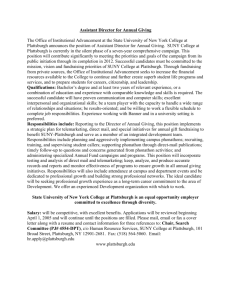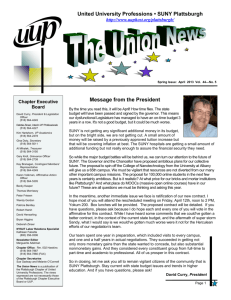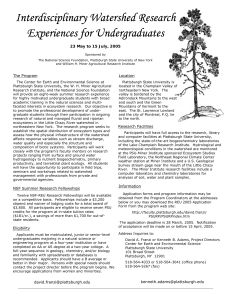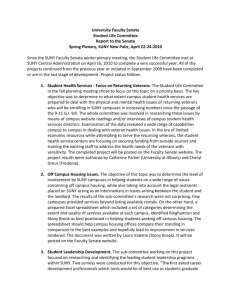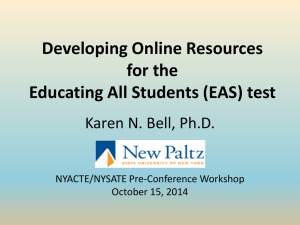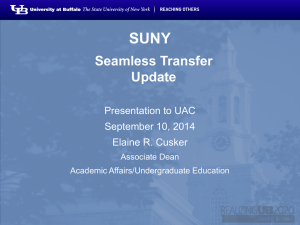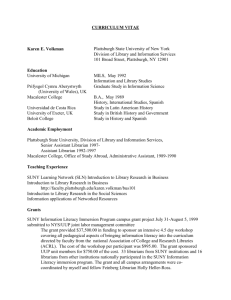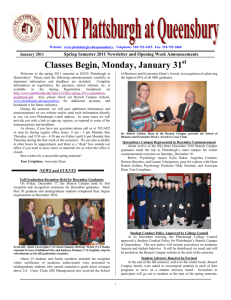Crisis Drill Article
advertisement
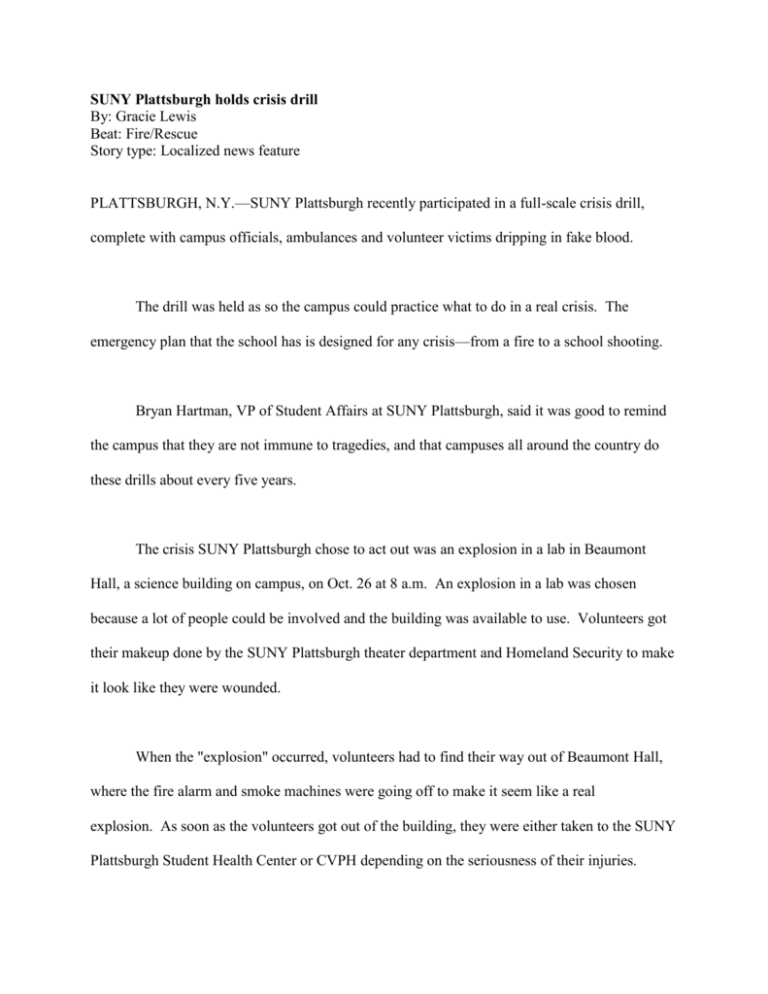
SUNY Plattsburgh holds crisis drill By: Gracie Lewis Beat: Fire/Rescue Story type: Localized news feature PLATTSBURGH, N.Y.—SUNY Plattsburgh recently participated in a full-scale crisis drill, complete with campus officials, ambulances and volunteer victims dripping in fake blood. The drill was held as so the campus could practice what to do in a real crisis. The emergency plan that the school has is designed for any crisis—from a fire to a school shooting. Bryan Hartman, VP of Student Affairs at SUNY Plattsburgh, said it was good to remind the campus that they are not immune to tragedies, and that campuses all around the country do these drills about every five years. The crisis SUNY Plattsburgh chose to act out was an explosion in a lab in Beaumont Hall, a science building on campus, on Oct. 26 at 8 a.m. An explosion in a lab was chosen because a lot of people could be involved and the building was available to use. Volunteers got their makeup done by the SUNY Plattsburgh theater department and Homeland Security to make it look like they were wounded. When the "explosion" occurred, volunteers had to find their way out of Beaumont Hall, where the fire alarm and smoke machines were going off to make it seem like a real explosion. As soon as the volunteers got out of the building, they were either taken to the SUNY Plattsburgh Student Health Center or CVPH depending on the seriousness of their injuries. Volunteers were also encouraged to post on a fake Facebook site and Twitter page so the college could practice responding to social media during crises. Mike Caraballo, Emergency Management Director at SUNY Plattsburgh and designer of the crisis drill, said, "Some of the things we practiced were evacuation of a building, communication to the campus communication to our incident management team and dealing with response and recovery.” According to Hartman, the crisis drill went extremely well. "People from Clinton County Emergency Services were impressed. They're involved in things like this all the time and they thought we did well. The plan we have in place is actually used by all types of emergency services, such as fire departments and EMTs.” Although the drill went well overall, Hartman said it highlighted some problems that the college needs to work on. The first problem was the Emergency Operations Center on campus has very old equipment, which prevented them from getting the most updated information on the crisis. Hartman said the college is going to have to find the money to get new equipment. Another dilemma the college had was they realized Caraballo had been given too much to do during a crisis. Caraballo's main role is to make sure the Emergency Operations Center is open, and bring people in to start to get things rolling. He said he expected to be the only one at the Emergency Operations Center, but when the time came for the drill, he got overwhelmed. "I started getting things ready for the activation of our emergency plan, but at the same time I was getting paged and answering phone calls," Caraballo said. One thing that the college did well was respond to the fake social media posts from the volunteers. Michelle Ouellette, Director of Public Relations and Marketing at SUNY Plattsburgh, diffused rumors started by the volunteers and removed content that was inappropriate. "We want to make sure that what is getting out on social media isn't hindering our process for recovery or starting rumors. Michelle put out what was truthful and stomped out what was inaccurate." Caraballo said. Olivia Cahill, a volunteer who was "burned" so bad she had to be taken to CVPH, said she was impressed at how quickly the college was responding to social media. "I was posting on the fake Facebook page that I heard there was a bomb in Beaumont Hall, which I completely made up, but I knew that if this were actually happening that’s something students would be saying. Right after I posted it the SUNY Plattsburgh account had responded saying people had searched the buildings and there was no bomb found," Cahill said. Cahill was also surprised at how realistic the drill was. "It was scary to try and get out of Beaumont. I’ve been through regular fire drills all the time where the fire alarm goes off and we have to evacuate the building, but having the obstacles like the smoke machines made it seem real," she said. Overall, the crisis drill was successful and a good learning experience to prepare campus officials and students for real emergencies. "There wasn't anything that went terribly wrong, and we got a lot of takeaways from it," Caraballo said. Source List: Bryan Hartman: (518) 564-2280 Mike Caraballo: (518) 564-4850 Olivia Cahill: (631) 902-9259 Make-up on one of the volunteers victim, Mitch Falanga’s, arms, along with an instruction tag on what his injuries were. “Dying” victims outside of Beaumont Hall. Campus officials and police officers meeting outside of Beaumont Hall. Evacuation from SUNY Plattsburgh buildings: Buildings must be evacuated when a fire alarm sounds or upon notice from University Police or authorities. Close all doors and use nearest exit. Tell others to exit the building. When outside, be at least 50 feet away from the building. Keep streets, fire lanes, hydrant areas and walkways clear for emergency vehicles and emergency personnel. Do not return to an evacuated building. In addition, dial 911 from a campus telephone for any fire, medical, or police emergency in order to be directly connected to Clinton County Office of Emergency Services. Safety tips from Mike Caraballo, Emergency Management Director at SUNY Plattsburgh.

